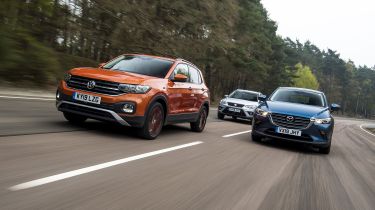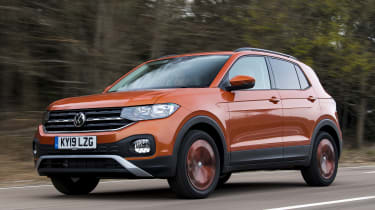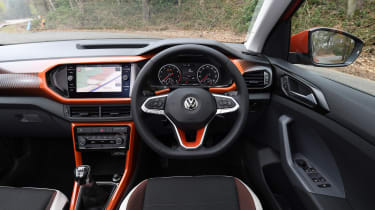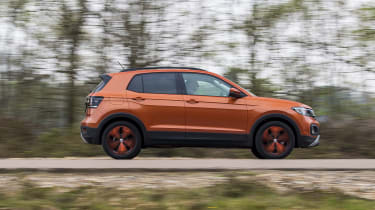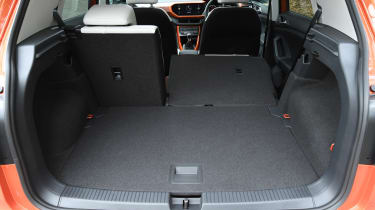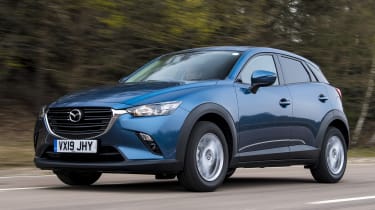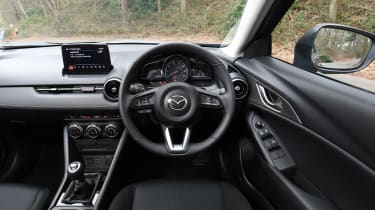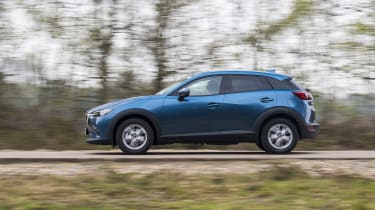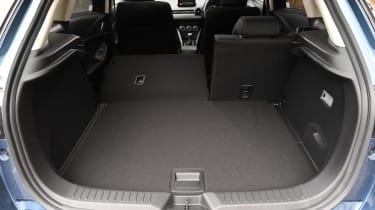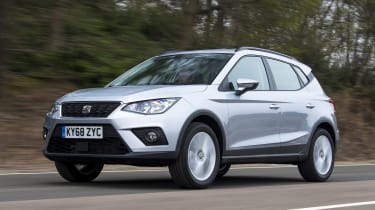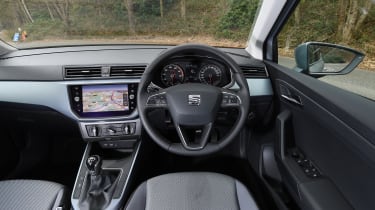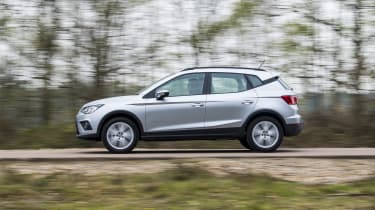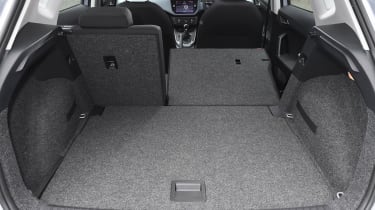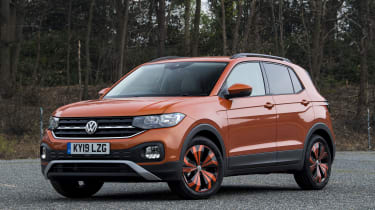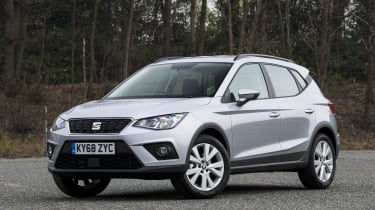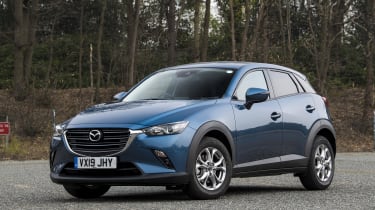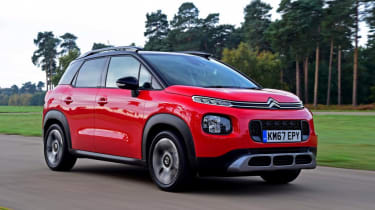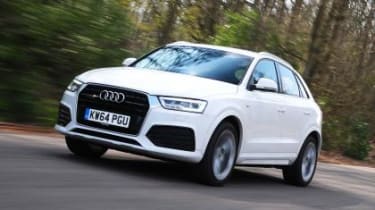Volkswagen T-Cross vs Mazda CX-3 vs SEAT Arona
VW are late to the small SUV party with the T-Cross - we test it against the SEAT Arona and Mazda CX-3 to see if it's been worth the wait
Volkswagen has taken its time to release a small SUV. The brand’s slightly larger T-Roc is a raised-up version of the firm’s Golf family hatchback, so think of this T-Cross as a jacked-up Polo.
It’s not quite as simple as that, but the supermini-based SUV class is booming; that much is obvious if you take a quick look at the number of rivals in this sector.
• Best small SUVs and crossovers to buy 2019
We’re putting the VW up against one of its toughest competitors: the SEAT Arona. This will be a big test, because the Spanish model uses similar components, so we’ll see if it can pull off yet another victory over this new German challenger or whether its fresher opposition gets the better of the Arona. The VW sits slightly more towards the premium end of the scale as well, so to reflect that we’re also throwing a revised Mazda CX-3 into the mix.
With even more upmarket appeal than before and great driving dynamics, too, the CX-3 received yet another update towards the end of last year, so the Japanese SUV also poses a stern test for the T-Cross.
But there’s more to the battle than that because cars in this class have to cover so many bases, so we’ll see where VW’s new arrival slots into the sector. The winner will have to balance style with practicality, driving dynamics with efficiency, and offer technology and affordability.
Volkswagen T-Cross
| Model: | Volkswagen T-Cross 1.0 TSI 115 SE |
| Price: | £19,555 |
| Engine: | 1.0-litre 3cyl turbo, 113bhp |
| 0-60mph: | 9.1 seconds |
| Test economy: | 46.3mpg/10.2mpl |
| CO2: | 112g/km |
| Annual road tax: | £140 |
Small SUV sales are booming, but it’s taken until now for Volkswagen to release a supermini-sized off-roader. The T-Cross is the brand’s smallest crossover, sitting beneath the slightly larger T-Roc in the range, and we’re testing what will be the best-seller here in the UK: the £19,555 1.0 TSI 115 manual in SE trim.
Used - available now

2022 Volkswagen
T-Cross
42,106 milesManualPetrol1.0L
Cash £13,406
2022 Volkswagen
T-Cross
16,861 milesManualPetrol1.0L
Cash £15,500
2022 Volkswagen
T-Cross
49,490 milesManualPetrol1.0L
Cash £12,231
2021 Volkswagen
T-Cross
55,793 milesManualPetrol1.0L
Cash £12,400Design & engineering
It will be the most popular spec because it offers the best balance between cost and kit. SE trim features the kind of equipment buyers want; there’s an eight-inch touchscreen with Apple CarPlay and Android Autoas standard. Sat-nav is a £725 extra, but many people won’t bother because integration with their phone gives them all the tech they are likely to need.
Alongside this you get autonomous braking, adaptive cruise and DAB radio, while there are some optional features that elevate the tech on offer inside, including the £375 Active Info Display digital dash.
However, the cabin isn’t the T-Cross’s strongest point. Quality is okay, but nothing more because there’s a lot of hard plastic – yet this at least means it should be hard-wearing and it hasn’t spoiled the design or ergonomics, which are sound. It also ensures the price is relatively affordable. At £19,555, it’s actually cheaper than the Arona by £855 due to the way SEAT structures its engine and trim line-up.
These cars share the MQB modular toolkit of parts, so the T-Cross is based on the MQB A0 platform and uses an identical 113bhp 1.0-litre three-cylinder turbo engine and six-speed manual gearbox as the Arona. The Mazda differs here because it’s not turbocharged.
All three cars have front-wheel drive, which makes sense, because few people will take these small SUVs away from the tarmac. They’re more about image and style, which is why VW offers different Design packs for £525, adding vibrantly coloured alloys, flashes of colour on the upholstery and a funky dash panel.
But given the way the T-Cross drives, it feels like it still lacks a definite personality, even with these more individual elements. It’s a slick and polished product on the move, yet maybe a bit short on character.
Driving
The MQB underpinnings mean the T-Cross is predictably good on the move, which we like. The ride sometimes feels busy, but at lower speeds around town, where the roads are more marked with grids and potholes, it’s compliant enough.
On faster routes is where the inconsistencies are more apparent, because the VW sometimes struggles to contain the energy being fired at its chassis due to the road surface. It’s not a big problem though, because comfort is still good, with decent body control and not much roll. Most of the motion you feel is well damped, but both the SEAT and Mazda seem just as sophisticated, so it’s not a trait that sets the VW apart from its competitors here.
It’s agile enough, too, partly down to the quick steering that means the T-Cross responds quickly to inputs at the wheel, even if it’s not easy to get a sensation of what’s going on at the road surface. One of the benefits of this very light steering is that Volkswagen’s newcomer is easy to manoeuvre and park, which will help when driving in town.
There’s plenty of refinement because the motor is smooth, and it delivers a decent slug of torque that’s sustained from low down into the mid-range, giving the car good enough performance. It’s not stunningly quick, but at 9.1 seconds from 0-60mph, it edged ahead of the SEAT by 0.1 seconds and trailed the Mazda by the same margin, so there’s very little in it.
The turbocharged T-Cross and Arona didn’t have too much of an advantage in gear, and all three were fairly evenly matched. While the VW and SEAT turn fewer revs at 70mph than the Mazda, which helped the CX-3’s performance, it hurt refinement because its engine is the noisiest and sounds strained.
Practicality
All T-Cross trim levels have a sliding rear bench to prioritise luggage room or passenger space. With the rear seat back there’s 385 litres on offer; that’s 15 litres down on the Arona but 35 litres up on the less spacious CX-3.
Slide the bench forward and there’s an impressive 455 litres of load space. However, in reality it’s best placed somewhere in the middle of its travel because furthest forward leaves almost no rear legroom.
It’s not entirely perfect, though, because with the seats forward there’s a big slot that items can drop through. With the bench in a mid-position rear legroom is okay; push it back and there’s easily as much room as in the Arona. Both beat the CX-3.
Ownership
VW’S 17th place in the makers’ chart of our Driver Power 2019 satisfaction survey wasn’t great, with SEAT 14th. Mazda owners’ views were much better; the brand came fourth.
Safety is better on the T-Cross, with autonomous braking, adaptive cruise and lane assist as standard, but you can’t add any extra safety tech. A rear-view camera, parking sensors and park assist cost £260, £450 and £580 respectively, but aren’t necessary.
Running costs
The T-Cross returned a respectable 46.3mpg and will cost around £1,502 in petrol per year. Most owners of these cars will be private buyers rather than company car drivers, so factors such as fuel consumption, insurance and servicing will be fairly important.
At a cost of £728 for our sample driver to insure a year and £297 for 24 months’ servicing, against £361 and £324 (two years) for the SEAT and Mazda’s £437 and £499, the VW’s running costs are competitive.
Testers’ notes: “There’s no four-wheel-drive model on offer, because most buyers in this class simply don’t want it. While a DSG auto is available on this 1.0 TSI 115 that costs £1,500, we’d stick with the manual.”
Mazda CX-3
| Model: | Mazda CX-3 2.0 SkyActiv-G SE-L Nav+ |
| Price: | £20,795 |
| Engine: | 2.0-litre 4cyl, 119bhp |
| 0-60mph: | 9.0 seconds |
| Test economy: | 41.1mpg/9.0mpl |
| CO2: | CO2: 141g/km |
| Annual road tax: | £140 |
The Mazda CX-3 received another facelift in 2018 to keep it competitive against newer rivals. Now there’s yet another challenger in the form of the T-Cross, so let’s see if the CX-3 can still cut it, tested here in £20,795 2.0 SkyActiv-G SE-L Nav+ form.
Design & engineering
In truth, the tweaks for this updated CX-3 aren’t exactly extensive. It’s had a few facelifts now since it was launched in 2015, with this revamp focusing on bringing the trim levels into line with the rest of the Japanese firm’s range.
The car is still based on the same SkyActiv platform and has a 119bhp 2.0-litre non-turbo petrol engine here. While that might seem familiar, this new unit gets innovations we’ve seen in other Mazdas, such as ‘edge cut’ pistons and higher-pressure injectors than before.
Next to the VW and SEAT, the big difference is that the CX-3 doesn’t feature a turbo. At 2.0 litres, it’s also twice the capacity. Mazda calls this ‘right sizing’ and has persevered with this approach. We’ll see how it compares on the move with its turbo rivals.
The car’s MacPherson-strut front and torsion-beam rear suspension is a similar set-up to the VW and SEAT’s chassis. It was tweaked with subtly different damper rates in a bid to improve ride quality, while an updated calibration for the steering means the CX-3’s fun-to-drive feel is still present.
Mazda’s G-Vectoring control features here, too. This system slightly reduces engine torque once it senses you turning the steering wheel to put more weight on the front axle and improve dynamics.
The new trim level structure includes this SE-L Nav+ model that gets even more kit compared with the VW, including sat-nav, Bluetooth, DAB radio, cruise control, parking sensors and heated seats.
While it’s more expensive, at £20,795, SE-L Nav+ is the lowest trim level available and comes with autonomous braking, a safety feature that all cars in this class should really get as standard now.
Inside, the CX-3 isn’t exactly known for having a super-plush cabin, but material quality is as good as its rivals’ here. While there are still plenty of firmer plastics to be found lower down and on the doors, some softer trim boosts the air of quality inside the Mazda. It’s still not high-end, though.
Driving
Despite its lack of a turbo, the CX-3 was the fastest car on test, taking 9.0 seconds to sprint from 0-60mph. However, this is achieved by revving the engine as hard as possible, so when the rpm is high in a sprint like this the Mazda is more at its best.
It is a noisy engine, though, so you might not want to extend it round towards the red line too frequently. The benefit is that the updated engine – which delivers 206Nm of torque at 2,800rpm, so not too much higher than its rivals’ torque peak – showed decent flexibility.
The CX-3 was only 0.3 seconds slower than the SEAT between 50 and 70mph in top gear. In lower gears it was close enough to its rivals that the very slight performance deficit won’t be all that noticeable on the road. The six-speed manual’s gearchange is the nicest here, with a good balance between interaction and refinement. It feels a little freer and more positive than its rivals’ actions.
But the car isn’t as comfortable. While the damping has plenty of body control, the wheels thump a little more and the level of comfort isn’t quite as strong.
The SEAT feels as sporty but rides more smoothly; still, at least the Mazda’s steering has a nice weight and speed, so it feels keen to change direction thanks to this and the set-up of the chassis. Where it really loses out is for refinement. Even at lower revs the engine is noisy and sounds coarse compared with the quieter turbocharged units in its rivals.
Practicality
SE-L Nav+ trim features a 350-litre boot, so even with the VW in its smallest load space configuration, the CX-3 is 35 litres down. This rises to 50 litres compared with the SEAT.
There’s enough space for shopping bags and maybe shorter family trips, but ultimately the Mazda loses out to the VW and SEAT when it comes to flexibility. The rear of the CX-3 is noticeably more cramped, while the front of the cabin doesn’t feel as spacious, either. The roof and window line don’t help the feeling of room in the back and also impact visibility.
Storage room isn’t as good as in either rival, but there’s enough for mobiles, wallets and other items.
Ownership
When Mazda updated its CX-3 last year, it also added some more safety kit, so there’s now pedestrian detection as standard, alongside autonomous braking. This isn’t on all spec levels, though; SE-L Nav+ is the lowest trim with this tech and it’s not available as an option elsewhere. The CX-3 retains its five-star Euro NCAP safety rating, however.
Mazda easily beat its rivals in our Driver Power 2019 satisfaction poll, finishing fourth in the makers’ chart, so the overall ownership prospects are good.
Running costs
One area where the CX-3 falls down is CO2 emissions, partly due to its non-turbo engine. The Mazda emits 141g/km, putting it in the 32 per cent Benefit-in-Kind tax bracket. This compares with the 112g/km T-Cross and 114g/km for the Arona, which both fall into the 26 per cent class.
As the Mazda is also the most expensive choice, it’ll be the priciest company car to run. Higher-rate earners will pay £2,628 per year. Company car tax stands at £2,010 and £2,099 for the VW and SEAT respectively.
At least the CX-3 returned 41.1mpg, so you’ll spend £1,692 on fuel a year based on these figures.
Testers’ notes: “Despite the latest round of updates, the CX-3 is starting to feel its age now. It was never the biggest car in its class, but its limited practicality compared with these two more flexible machines is obvious.”
SEAT Arona
| Model: | SEAT Arona 1.0 TSI 115 FR |
| Price: | £20,410 |
| Engine: | 1.0-litre 3cyl turbo, 113bhp |
| 0-60mph: | 9.2 seconds |
| Test economy: | 42.1mpg/9.3mpl |
| CO2: | 114g/km |
| Annual road tax: | £140 |
The Arona is one of the cars the T-Cross will have to beat, and the competition will be close given the two models share so much. We’re testing the £20,410 1.0 TSI 115 FR model – the entry-level trim with this engine and manual box combination, making it more expensive than the Volkswagen.
Design & engineering
Due to the fact the Arona is also based on the VW Group’s MQB set-up, it shares many components with the T-Cross, including the same modular chassis, the front MacPherson strut and rear torsion-beam suspension, as well as the engine and gearbox.
That means it’s also a 113bhp 1.0-litre turbocharged three-cylinder motor powering the SEAT here, with an identical 200Nm of torque. Both these figures are produced at the same revs, while there’s only 14kg between them in the VW’s favour, so it’s no surprise that performance was similar between the pair.
The cars share a six-speed gearbox and a front-wheel-drive layout, but the designs outside are obviously different; the SEAT has a more angular look, the VW a slab-sided, solid stance.
The two look different inside, but share the same tech and some of the same problems, those being the harder plastics on the doors and centre console, even if the SEAT’s dash top is okay. Quality is similar, but the Arona has the advantage when it comes to kit.
Sat-nav, CarPlay, Android Auto, LED lights, cruise and climate control, parking sensors and autonomous braking are all included as standard, even if the Arona FR costs £855 more than the VW.
It is worth mentioning that SEAT is currently offering a £1,000 voucher off the Arona’s list price, making the effective cost £19,410, and therefore £145 cheaper than the T-Cross.
Driving
The Arona feels similar to the T-Cross on the move; it’s no surprise because the two cars share much of their mechanical make-up, so should seem alike. Although the SEAT rides a little better, it’s justas refined and as flexible as the Volkswagen.
The Arona took 9.2 seconds to go from 0-60mph compared with 9.1 seconds for the T-Cross, while an identical torque output meant in-gear performance was similar, if slightly in the SEAT’s favour.
It took 4.3 seconds between 30 and 50mph in third compared with 4.6 seconds for the T-Cross, for example, while the Arona managed 12.2 seconds between 50 and 70mph in sixth against the VW’s 12.4. Both cars offer an adequate level of performance, with a nice, solid and mechanical feel to features such as the gearchange, but compliance to the ride.
The SEAT is very similar to the Volkswagen even in sportier FR specification; its dampers submit to most bumps in the road sweetly and control the body well. Steering is direct and weightier than in the T-Cross, so it’s also a little sharper and more engaging to drive, because it rolls a little less, too.
It doesn’t feel quite as susceptible to some of the road surface cracks and crevices that upset the T-Cross at lower speed, but that trait is still present. However, neither car is uncomfortable and both feel quite nicely settled at mid speeds. It feels planted and refined as well. The engine is quiet and the ride composed, but the Spanish crossover just has the edge over the Volkswagen for this balance between dynamic ability, comfort and refinement.
Practicality
The Arona doesn’t boast the VW’s sliding seat arrangement, but with 400 litres of boot space, there’s more than enough capacity for a family’s bags, while the legroom in the rear of the cabin is good for a compact SUV.
The T-Cross offers slightly more space with its rear bench all the way back, but then you compromise boot room. With it all the way forward, the Arona has the advantage, so despite the VW’s extra practicality on the face of things, there really isn’t too much to separate these two mechanically similar cars.
Features such as the big storage tray in front of the gearlever, which doubles as a wireless charging tray for your mobile phone, plus two cup-holders, mean the Arona’s cabin is also more practical than it might look at first glance. Both models have more space and, therefore, usability than the Mazda.
Ownership
There's a good level of safety kit as standard in the SEAT, with autonomous braking featuring on all trim levels. Euro NCAP hasn’t tested the T-Cross yet, but the Arona scored a full five-star safety rating from the body. We’d expect similar from the VW when it’s rated.
Due to the way SEAT structures the Arona trim range you can’t update it with any further safety kit, which is a slight disadvantage, but there are six airbags and parking sensors included, too.
SEAT beat Volkswagen in our owner satisfaction survey this year, finishing 14th in the makers’ chart, but both brands were still some way behind Mazda.
Running costs
Our experts’ predicted residual value of 49.7 per cent means private buyers will lose £10,260 on the Arona and the car will therefore be worth £10,150 after three years or 36,000 miles. The CX-3 and T-Cross are expected to retain 50.5 and 53.9 per cent respectively.
This equates to depreciation of £10,296 for the Mazda and £9,025 for the Volkswagen, which means the two models will be worth £10,499 and £10,530 respectively. The SEAT also managed a fairly solid 42.1mpg fuel economy on test, so will cost £1,652 to fuel a year. This is more than the new T-Cross, but is still not a bank-breaking cost
Testers’ notes: "There’s maybe not quite as much scope for personalisation as on the T-Cross here, but with contrasting roof colours and the silver blade on the C-pillar, the Arona is still a sharp-looking car."
Verdict
First place: Volkswagen T-Cross
The VW just edges the SEAT to the top spot. It’s slightly more practical, gets as much kit as you’d want (although it doesn’t feature the same level of equipment as the SEAT) and is a little cheaper. The big boot, roomy cabin, great infotainment and smooth, refined engine that delivers strong economy and enough performance are enough to secure the victory. But the car is still a little bland, despite personalisation options.
Second place: SEAT Arona
Even with a voucher offer at the moment, cost is one of the main reasons the Arona loses out to the T-Cross here, because it gets more kit than the VW and is pretty much just as practical. However, it’ll cost more to run, even if it’s as affordable on PCP, which is how most people purchase cars in this class. It’s still a great buy, with a nice engine and a strong balance between comfort and practicality.
Third place: Mazda CX-3
Despite updates to the CX-3 with two facelifts in as many years, Mazda’s compact SUV still can’t compete with these more modern and more practical machines. It’s good to drive and the engine updates have helped, but the CX-3 doesn’t ride as well as its rivals here and isn’t as refined. It’s also pricier than both competitors, but you don’t get much more in the way of kit, plus it’s less spacious than them, too.
Also consider...
Citroen C3 Aircross
Model: Citroen C3 AirCross PT 110 FlairNew price: £20,045Engine: 1.2-litre 3cyl, 108bhp
Top-spec Flair trim gets a sliding rear seat, similar to the T-Cross, so with up to 520 litres of boot space, practicality is a given. The Citroen C3 Aircross Flair has loads of kit, too, so you won't want for anything, while the engine is strong. It's not as refined as the VW, though.
Audi Q3
Model: Audi Q3 1.4 TFSI S lineUsed price: £20,000 Engine: 1.4-litre 4cyl, 148bhp
For similar sort of money, you could have a more premium-feeling Audi Q3. While it might not be as practical, its 1.4 TFSI engine has more grunt and is nicely refined. A 2016 car with around 20,000 miles on the clock in sport S line trim costs £20,000.
Figures
| Volkswagen T-Cross 1.0 TSI 115 SE | Mazda CX-3 2.0 SkyActiv-G SE-L Nav+ | SEAT Arona 1.0 TSI 115 FR | |
| On the road price/total as tested | £19,555/£22,615 | £20,795/£21,345 | £20,410/£20,410 |
| Residual value (after 3yrs/36,000) | £10,530/53.9% | £10,499/50.5% | £10,150/49.7% |
| Depreciation | £9,025 | £10,296 | £10,260 |
| Annual tax liability std/higher rate | £1,005/£2,010 | £1,314/£2,628 | £1,050/£2,099 |
| Annual fuel cost (12k/20k miles) | £1,502/£2,504 | £1,692/£2,821 | £1,652/£2,754 |
| Insurance group/quote/VED | 10/£728/£140 | 15/£437/£140 | 12/£361/£140 |
| Servicing costs | £297 (2 years) | £499 (3 years) | £324 (2 years) |
| Length/wheelbase | 4,108/2,551mm | 4,275/2,570mm | 4,138/2,566mm |
| Height/width | 1,584/1,760mm | 1,535/1,765mm | 1,543/1,780mm |
| Engine | 3cyl in-line/999cc | 4cyl in-line/1,998cc | 3cyl in-line/999cc |
| Peak power/revs | 113/5,000 bhp/rpm | 119/6,000 bhp/rpm | 113/5,000 bhp/rpm |
| Peak torque/revs | 200/2,000 Nm/rpm | 206/2,800 Nm/rpm | 200/2,000 Nm/rpm |
| Transmission | 6-speed man/fwd | 6-speed man/fwd | 6-speed man/fwd |
| Fuel tank capacity/spare wheel | 40 litres/£115 | 48 litres/space saver | 40 litres/£105 |
| Boot capacity (seats up/down) | 385-455/1,281 litres | 350/1,260 litres | 400 litres/N/A |
| Kerbweight/payload/towing weight | 1,175/555/1,100kg | 1,230/462/1,200kg | 1,189/521/1,200kg |
| Turning circle | 10.6 metres | 11.4 metres | 10.6 metres |
| Basic warranty (miles)/recovery | 3yrs (60,000)/1yr | 3yrs (60,000)/3yrs | 3yrs (60,000)/2yrs |
| Driver Power manufacturer/dealer pos. | 17th/18th* | 4th/24th* | 14th/23rd* |
| NCAP: Adult/child/ped./assist/stars | TBC | 85/79/84/64/5 (2015) | 95/80/77/60/5 (2017) |
| 0-60/30-70mph | 9.1/9.6 secs | 9.0/8.7 secs | 9.2/9.1 secs |
| 30-50mph in 3rd/4th | 4.6/6.5 secs | 4.4/6.0 secs | 4.3/6.0 secs |
| 50-70mph in 5th/6th | 9.0/12.4 secs | 8.0/12.5 secs | 8.7/12.2 secs |
| Top speed/rpm at 70mph | 120mph/2,400rpm | 119mph/2,500rpm | 113mph/2,400rpm |
| Braking 70-0/60-0/30-0mph | 47.3/34.4/8.9m | 50.5/37.2/9.0m | 47.6/35.0/8.9m |
| Auto Express econ. (mpg/mpl)/range | 46.3/10.2/407 miles | 41.1/9.0/434 miles | 42.1/9.3/370 miles |
| WLTP combined mpg | 46.3-47.9mpg | 36.2-48.7mpg | 45.6-49.6mpg |
| WLTP combined mpl | 10.2-10.5mpl | 8.0-10.7mpl | 10.0-10.9mpl |
| Actual/claimed CO2/tax bracket | 141/112g/km/26% | 159/141g/km/32% | 155/114g/km/26% |
| Airbags/Isofix/park sensors/camera | Six/yes/£450/£260 | Six/yes/yes/£204 | Six/yes/yes/no |
| Auto box/lane keep/blind spot/AEB | £1,500/yes/no/yes | £1,000/yes/no/yes | £1,080/no/no/yes |
| Clim/cruise ctrl/leather/heated seats | £845/adaptive/n/£300 | Yes/yes/no/yes | Yes/yes/no/no |
| Metallic/LEDs/keyless/power tailgate | £575/£1,065/£340/no | £550/no/no/no | Yes/yes/no/no |
| Nav/digital dash/DAB/connected apps | £725/£375/yes/yes | Yes/no/yes/yes | Yes/no/yes/yes |
| Wireless charge/CarPlay/Android Auto | No/yes/yes | No/£110**/£110** | Yes/yes/yes |
